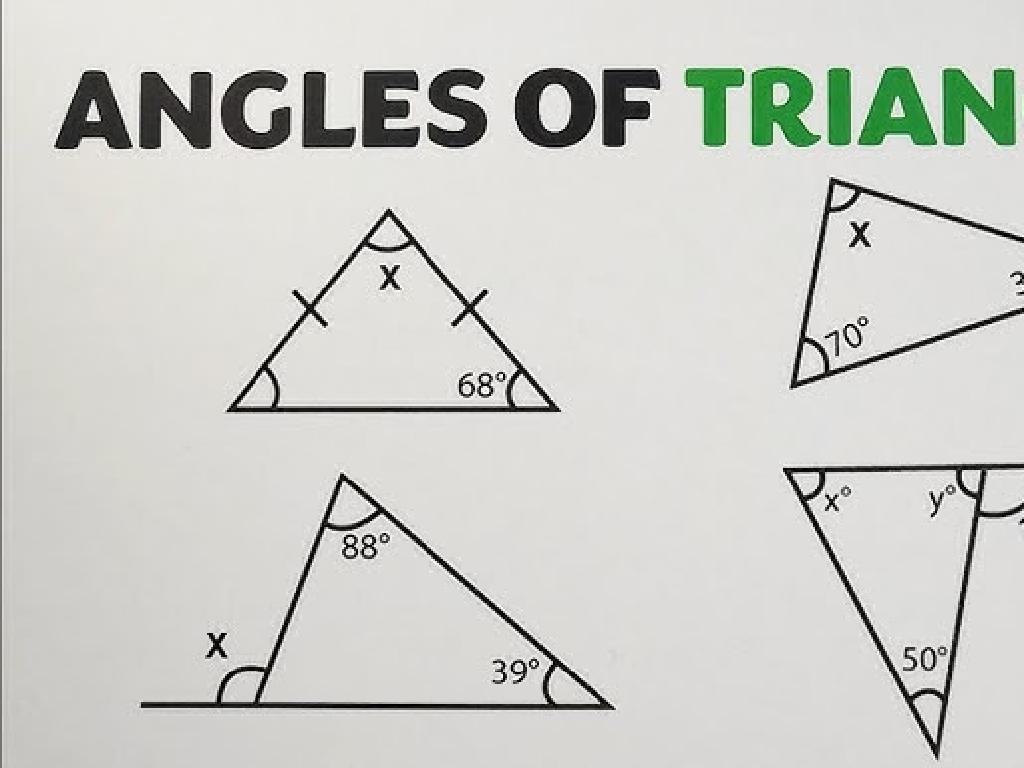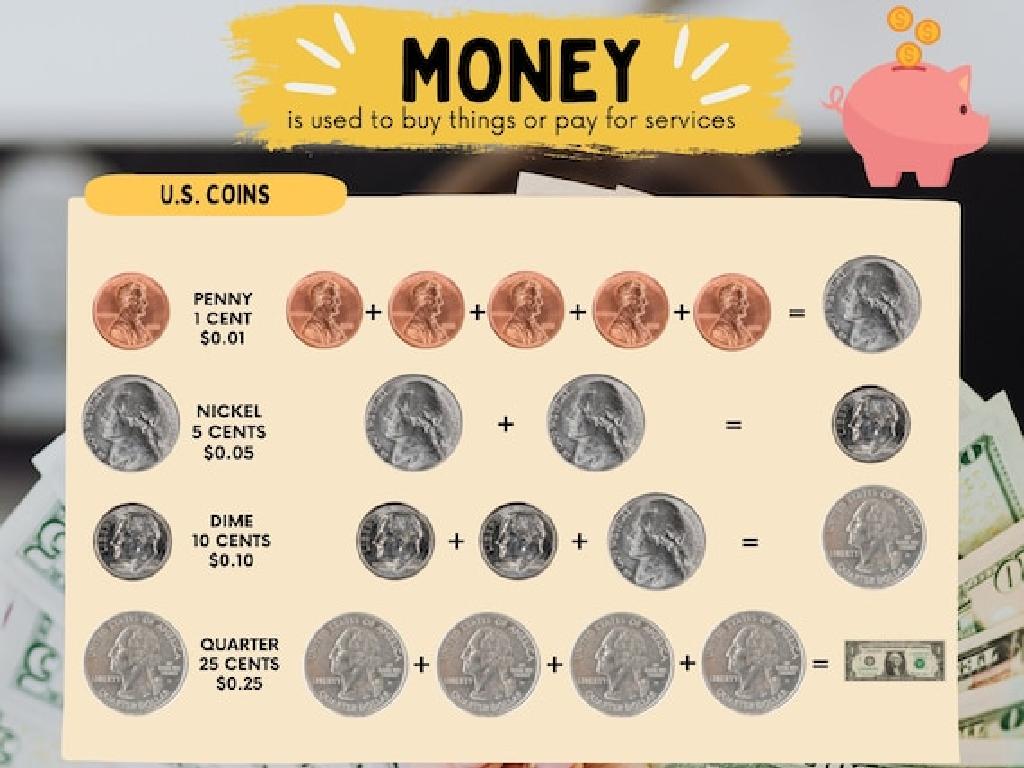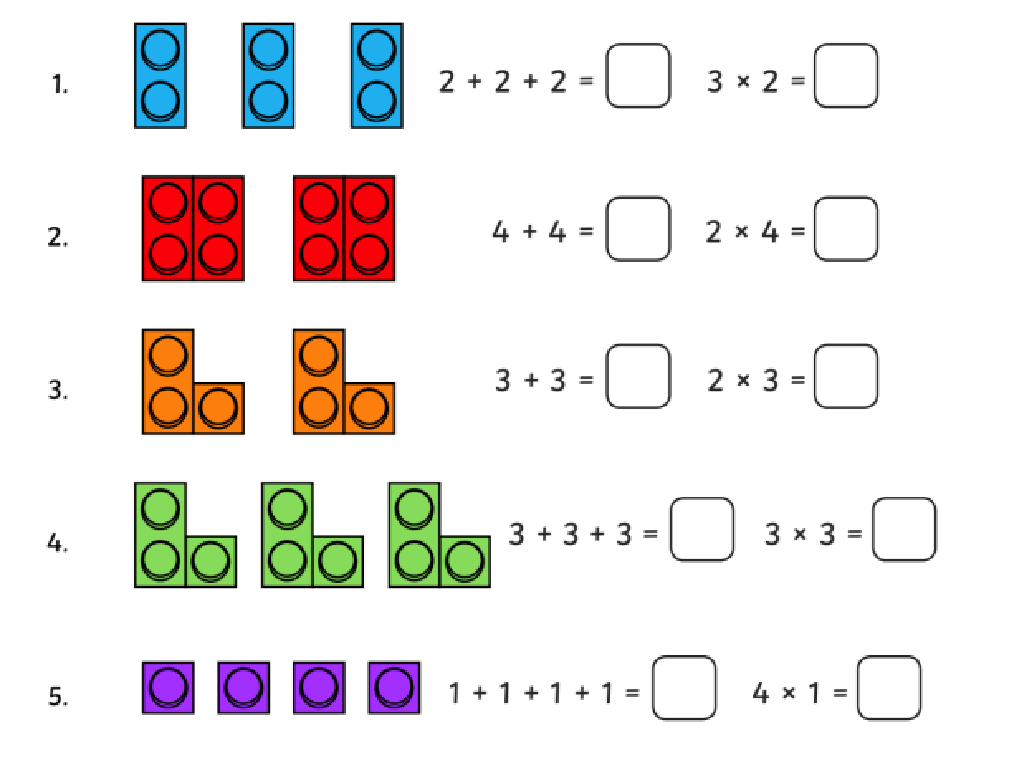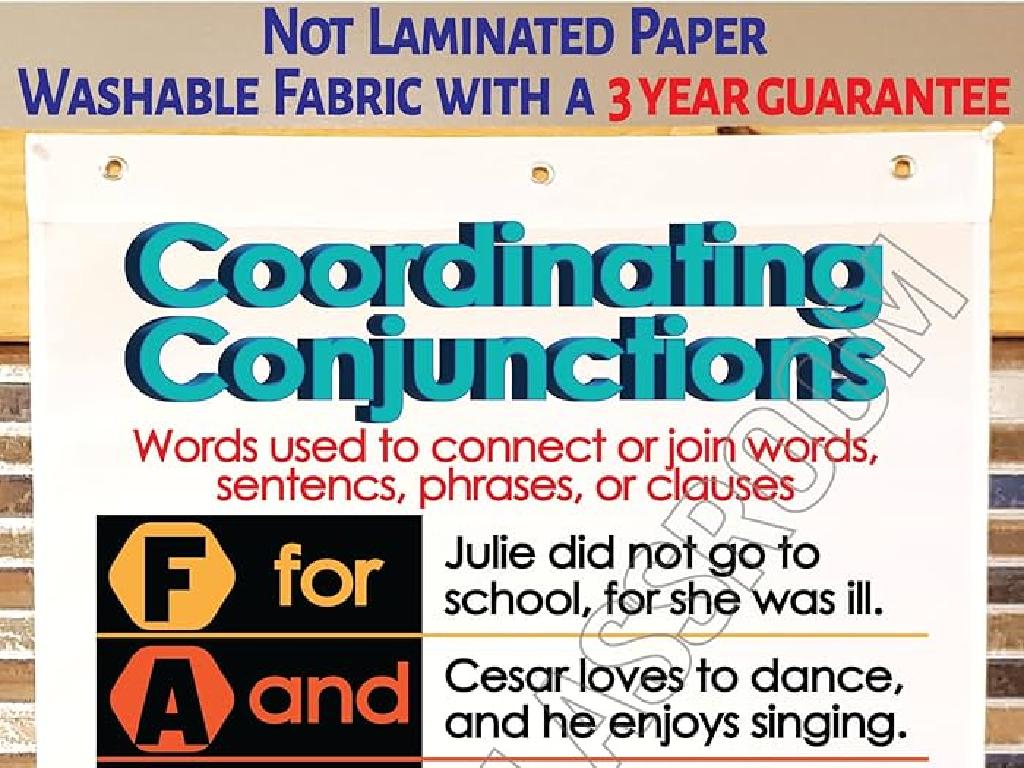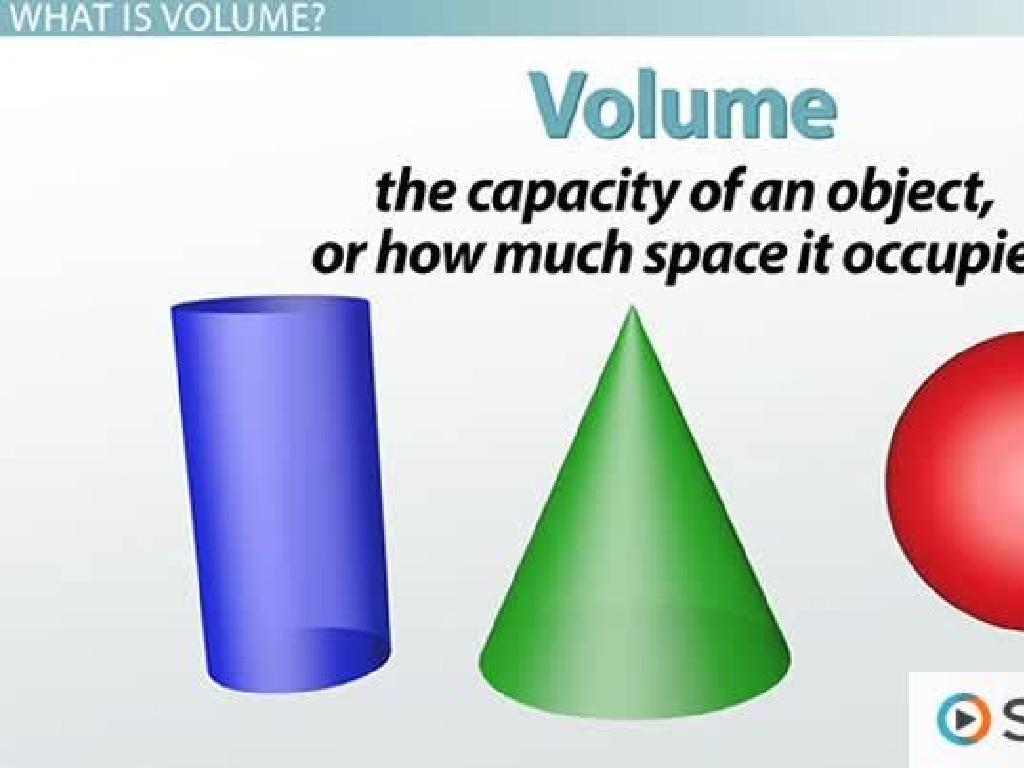Which Word Does Not Rhyme?
Subject: Language arts
Grade: Kindergarten
Topic: Rhyming
Please LOG IN to download the presentation. Access is available to registered users only.
View More Content
Welcome to Rhyming Words!
– Discover words that sound the same
– ‘Cat’ and ‘hat’ rhyme
– Words that have the same ending sound
– Find the odd word out
– Which word doesn’t fit? Cat, Bat, Dog
– Practice with fun rhymes
– We’ll play games to learn about rhymes
|
This slide introduces kindergarteners to the concept of rhyming words in a fun and interactive way. Start by explaining that rhyming words are words that have the same ending sound, like ‘cat’ and ‘hat’. Engage the children by asking them to think of words that sound alike. Then, move on to teaching them how to identify words that do not rhyme with the others by giving examples and playing rhyming games. Encourage participation and praise their efforts to build confidence. The goal is to make them comfortable with listening for and recognizing rhymes.
Rhyming Words
– What does ‘rhyme’ mean?
– Rhyme means words sound the same at the end.
– Words with the same ending sound
– ‘Dog’ and ‘frog’ both end with ‘og’
– Like ‘log’ and ‘hog’ also rhyme with ‘dog’ and ‘frog’.
– Let’s listen and find rhymes!
– We’ll say words out loud to hear the rhyme.
|
Introduce the concept of rhyming by explaining that rhyming words have the same ending sound. Use simple, familiar words as examples to illustrate the concept. Make sure to articulate the ending sounds clearly. Engage the students by listening to rhyming words together and encourage them to participate by identifying rhymes. This will help them develop phonemic awareness, which is crucial for early reading skills. You can turn this into a fun activity by having the children listen to a series of words and pick out the ones that rhyme, or by having them come up with their own rhyming words.
Listening to Rhymes: Which Word Doesn’t Belong?
– Listen to words I read aloud
– Clap when words sound the same
– Rhyming words end the same way
– Words like ‘cat’ and ‘hat’ rhyme
– Spot the word that doesn’t rhyme
– If I say ‘dog, frog, log, cat’, which doesn’t fit?
|
This slide is for an interactive class activity focused on listening and identifying rhyming words. As you read words aloud, encourage the students to listen for the sounds at the end of each word. When they hear words that rhyme, they should clap their hands. This will help them to tune into the auditory aspect of rhyming. Explain that rhyming words have the same ending sounds, like ‘cat’ and ‘hat’. To practice, give them a set of words where one does not rhyme, such as ‘dog, frog, log, cat’, and ask them to identify the odd one out. This activity will enhance their phonemic awareness and ability to distinguish rhyming words in a fun and engaging way.
Rhyme Time: Finding the Odd One Out
– Words that sound the same at the end rhyme
– ‘Cat’ and ‘Bat’ rhyme
– They both end with the ‘at’ sound
– ‘Sun’ does not rhyme with ‘Cat’ or ‘Bat’
– ‘Sun’ ends with a different sound, ‘un’
– Let’s practice finding non-rhyming words
– We’ll look at groups of words and pick the odd one out
|
This slide introduces the concept of rhyming to Kindergarten students by identifying words that do not rhyme within a group. Start by explaining that rhyming words have the same ending sounds. Use ‘Cat’ and ‘Bat’ as examples of rhyming words and ‘Sun’ as a non-rhyming word. Encourage the students to listen to the sounds at the end of each word to determine if they rhyme. Practice with more examples in class, and ask students to explain why certain words do not rhyme. This activity will help develop phonemic awareness and is a fundamental skill in early reading development.
Rhyme Time Game
– I’ll show three words
– Find the non-rhyming word
– Words like ‘cat’, ‘hat’, ‘dog’. Which is different?
– Thumbs down for non-rhyme
– If ‘dog’ doesn’t rhyme, show thumbs down
– Ready? Let’s play Rhyme Time!
|
This slide introduces the Rhyme Time game to help Kindergarten students understand rhyming words. Display three words at a time, ensuring two words rhyme and one does not. Encourage the children to identify the odd one out. When a student finds the non-rhyming word, they should show a thumbs down. This activity will help students listen for and recognize rhyming patterns, an essential skill in language arts. For the activity, prepare sets of words in advance, some that rhyme and some that don’t, and guide the students through the game, offering praise and assistance as needed.
Finding the Odd Rhyme Out
– Look at examples on the board
– Find the non-rhyming word
– I’ll point to words, spot the different one
– Say words aloud together
– We’ll use our voices to hear the rhyme
– Listen for rhyming sounds
– Rhymes sound similar, one will sound different
|
This slide is designed to engage Kindergarten students in a group activity to identify non-rhyming words. Start by showing a set of words on the board, ensuring that one of the words in each group does not rhyme with the others. Guide the students to find the word that doesn’t fit by saying the words aloud together and listening for the ending sounds. Encourage them to listen carefully as rhyming words will have similar ending sounds, while the non-rhyming word will sound different. This activity helps develop phonological awareness, an essential skill for early reading development. Make sure to praise their efforts and correct gently, reinforcing the learning objective in a positive manner.
Your Turn to Find the Rhyme
– Look at your worksheets
– Circle the non-rhyming word
– Find the word that sounds different
– Share your answers with the class
– Have fun discovering rhymes!
– Rhyming is like a word game!
|
This slide is for a class activity where students will practice identifying rhyming words. Provide each student with a worksheet that has groups of words. In each group, one word will not rhyme with the others. The task for the students is to circle the word that does not fit. After completing the worksheet, students will have the opportunity to share their answers with the class, fostering a collaborative learning environment. As a teacher, walk around the classroom to assist any students who may be struggling and to encourage participation. Possible activities could include rhyming games, creating a rhyming word wall, or singing rhyming songs to reinforce the concept.
Rhyming Game: Find the Match for ‘Cat’
– Form a circle for our game
– Pass the ball and rhyme with ‘cat’
– Say words like ‘hat’, ‘bat’, or ‘mat’
– Can’t think of a rhyme? Pass it on!
– Listen and learn from friends
– Discover new words together
|
This interactive class activity is designed to help Kindergarten students recognize and produce rhyming words. By forming a circle and passing a ball, students will engage in a fun and collaborative game. When a student receives the ball, they must say a word that rhymes with ‘cat’. If they are unable to think of a rhyming word, they simply pass the ball to the next student. This encourages participation without pressure. As the teacher, facilitate the game and provide guidance as needed. Possible rhyming words include ‘hat’, ‘bat’, ‘mat’, ‘rat’, ‘sat’, and ‘pat’. If a student says a non-rhyming word, gently correct them and explain why it doesn’t rhyme. This activity promotes listening skills, as students must pay attention to the words their peers say, and it builds their phonemic awareness, an essential skill for early reading development.
Rhyming Recap: You’re All Stars!
– Excellent work with rhymes today!
– Rhyming words sound the same at the end.
– Words like ‘cat’ and ‘hat’ rhyme because they both end with ‘at’.
– You’re all Rhyming Stars!
– Can’t wait to see you next time!
|
This slide is meant to conclude the lesson on rhyming words. Praise the students for their efforts in identifying rhyming and non-rhyming words. Reinforce the concept that rhyming words have the same ending sounds, which is a crucial aspect of phonological awareness in early literacy. Use examples like ‘cat’ and ‘hat’ to illustrate your point. Encourage the children by calling them ‘Rhyming Stars’ to boost their confidence and excitement about learning. Let them know you look forward to their continued learning and exploration of rhymes in future lessons.

